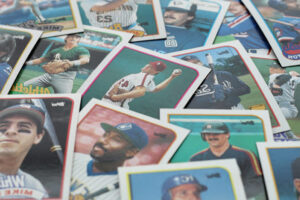Few eras of human history faced more strife than the 1940s, but facing strife makes sports even more important. Baseball provided needed relief from the troubles of the time. The departure of many pro baseball players for the war shook up the league’s usual flow as well.
The World Series champions of the 1940s represent a changing era for the sport. Which major league players stood out during World War II and the golden age of the minor leagues? Whose stars rose as American baseball integrated?
In this article, we’ll cover the 1940s baseball champions and what made each team unique.
1940: Cincinnati Reds Become World Series Champions
Cincinnati took home its second World Series title in 1940, playing against the Detroit Tigers in a seven-game series. The Reds suffered a crushing loss against the New York Yankees in the previous year’s event, making this a redemption story for Cincinnati’s ball club.
One of the most unique stories among these 1940s baseball champions doesn’t involve a player on the field. This win made manager Bill McKechnie the first manager to win World Series titles with two different teams.
1941: New York Always Wins
1941 saw the Brooklyn Dodgers and New York Yankees go head-to-head, with the Yankees continuing an era of World Series history dominated by their victories. Five New York Yankees players from this team went on to the Baseball Hall of Fame, as did manager Joe McCarthy. This so-called “Subway Series” saw great, memorable plays by almost every member of the Yankees, though.
1942: Cardinals Roost
While the New York Yankees returned the following year, the St. Louis Cardinals brought home their first World Series victory in almost a decade. This victory showed the strength of the St. Louis Cardinals’ farm system, with all but one player coming through that system. Some of the Cardinals that made this one of the greatest 1940s teams included Stan Musial and Enos Slaughter.
Musial’s star continued to rise well after this game. This unorthodox player continued his dominance for two decades, becoming one of the greatest hitters of the 1950s.
1943: A Rematch Amid War
The Cardinals and Yankees clashed again in 1943, but both teams had to change things during World War II. The Yankees came out on top, but both teams had lost five top players from their previous-year rosters. This World Series marked the last year for Joe McCarthy, who had managed the Yankees through this legendary era of the ball club.
Hall-of-Famer Bill Dickey put in a memorable performance during this series. During the fifth and final game, he closed things out with a two-run homer.
1944: St. Louis Showdown
Two St. Louis teams, the Cardinals and the Browns, came together in what many consider the weakest World Series in modern baseball. The St. Louis Cardinals took home another victory, but neither team’s roster looked strong.
Yet again, Stan Musial put in a strong performance. His home run in Game 4 signaled a death knell for the Browns, who never recovered during that game and scored only two runs across Games 4, 5, and 6.
1945: Tigers and Bears, Oh My
The Detroit Tigers brought home the title in a seven-game series remembered as one of the worst in World Series history. They set the record for most players fielded during a World Series in the process, though, coming in at 26. (Two ball clubs have tied this record, one of which this article will discuss in a moment.)
Despite the weak play, two Detroit Tigers from this team entered the Hall of Fame. Hank Greenberg entered in 1956, while Hal Newhouser entered in 1992.
1946: Cardinals Take Flight
Players returned from military service, the government lifted wartime travel restrictions, and baseball returned to normal after a few shaky years. With this came an improvement in the quality of play during a matchup between the St. Louis Cardinals and the Boston Red Sox. The latter tied the record for players fielded during the World Series but didn’t bring home the title.
The victorious Cardinals saw a moment that defined the club’s legend in Slaughter’s Mad Dash. Enos Slaughter sprinted from third base to home, seeing weakness in the Red Sox after center fielder Dom DiMaggio pulled a hamstring. This sprint scored the Series-winning run for the Cardinals, who memorialized the moment with a statue.
1947: Subway Series Rematch
The first televised World Series saw two New York teams come together yet again, and like before, the New York Yankees brought it home. Both rosters contained many inductees to the Hall of Fame. Manager Bucky Harris, himself a World Series winner in 1924, shepherded the team to a victory in Game 7.
1948: Cleveland Indians’ Stacked Roster
With six players who would go on to enter the Baseball Hall of Fame, the Cleveland Indians beat the Boston Braves in 1948. This star-studded lineup included 1940s sports legends Bob Feller, Bob Lemon, Satchel Paige, Joe Gordon, Larry Doby, and Lou Boudreau.
For these baseball champions, the 1940s marked the first time both participating teams had previous World Series wins but no previous World Series losses. Only four teams remain that could participate in such a match today.
1949: Yet More Yankees
The Brooklyn Dodgers and the New York Yankees clashed for the third time, with the Yankees claiming the crown. While the 1930s and 1940s had already seen strong Yankee lineups, this set off a run of near-complete Yankee dominance that lasted for years.
Many of the players on this year’s Yankee team continued playing for years to come. The mystique of such a dominant roster helped propel the rise of vintage baseball cards.
A Legendary Era Despite Difficulties
Even though it faced some hiccups, the 1940s did see many of baseball’s greatest World Series champions establish their legends. The players of this era hold a special place in history due to the rise of television during the late 1940s.
If you want to buy vintage cards from this era or sell your collection, contact us at American Legends. For over 30 years, we’ve handled collections of historic sports cards, including legendary pieces like 1952 Topps cards and uncut sheets from the 1940s.


